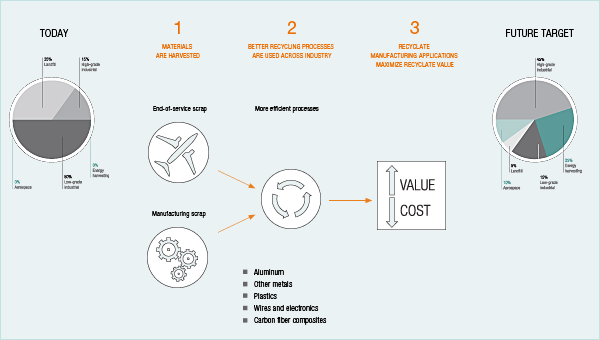
BENEFITS FOR OPERATORS
AFRA has simplified the recycling process for airline customers seeking a responsible way to manage the airplanes that they retire by establishing minimum standards for how airplanes should be dismantled. By choosing an AFRA-accredited facility to scrap out their airplane, the airplane owner has an assurance that the facility has the expertise and processes to ensure that fewer parts are damaged by being removed and handled incorrectly and that the parts of the airplane that can’t be reused are managed in an environmentally responsible manner. As a result, AFRA expects to maximize the value of reusable parts as airlines work to recertify used parts and install them in operational airplanes.
AFRA-accredited companies are independently audited and verified to use scrapping processes that maximize environmental responsibility. For example, AFRA’s “Best Management Practice for Management of Used Aircraft Parts and Assemblies” specifies that “environmental concerns should be addressed through appropriate control technologies with sufficient capacity to handle largest liquid storage tank/system” on the airplane. The AFRA document not only defines the minimum standard but also suggests control technologies a facility might employ to meet the standard. In this example suggested options include:
- Fully protected ground surface.
- Storm-water runoff pathways physically protected with spill barrier equipment (e.g., drains, culverts, channels).
- Pumping and storage capacity immediately accessible.
- Oil/water separator.
- Wastewater treatment with airplane fluid capabilities.
- Spill kits with sufficient absorptive materials.
Although there are additional costs involved with recycling airplanes in the manner dictated by AFRA, the group believes that these costs can be offset by the higher value of recyclates — recycled material that will be used to form new products — recovered by new recycling processes (see fig. 3). With Boeing expecting some 8,500 commercial airplanes to be retired by 2025, AFRA hopes its efforts will benefit both airlines faced with end-of-service airplanes and the environment by reducing the amount of airplane material that goes into landfills.
MOVING TOWARD A MORE EFFICIENT RECYCLING PROCESS
Figure 3
AFRA’s goal is to achieve the highest possible commercial value for reclaimed materials, which would reduce the total cost of recycling airplanes for commercial airlines.

[+] Enlarge
SUMMARY
Boeing continues to work with AFRA, which is focused on safe and sustainable solutions for the reuse of airplane parts, assemblies, and recovered materials from retired airplanes, with the ultimate goal of improving industry sustainability. AFRA’s strong belief is that end-of-service airplane owners will preferentially seek out companies whose operators have been independently reviewed and accredited to embody the expertise and process fidelity that will realize greatest value at lowest risk. The organization publically distributes the information and processes it develops in a series of documents on its Web site: www.AFRAAssociation.org.
For more information, contact Bill Carberry at william.l.carberry@boeing.com.
The Promise of
Recycled Carbon Fiber
The introduction of the largely composite Boeing 787 Dreamliner presents new opportunities in composite recycling. For the past several years, Boeing has been working with a number of third-party technology firms on the recycling of aerospace-grade composites. Boeing began these efforts in 2004 with the first tests using scrap carbon-fiber-reinforced-plastic (CFRP) composite from retired F-18A airplanes. More recent tests have used 777 and 787 composite manufacturing scrap. Boeing research has demonstrated not only that the carbon fibers in CFRP can be recovered, but that the fiber?s surface characteristics, bond-ability with new resin, and overall quality are comparable to that of new fiber and suitable for use in high-end industrial manufacturing.
Recent Boeing research has focused on using recycled 777 and 787 CFRP in high-end industrial manufacturing applications that include electronics casings using required radio frequency shielding and high-end automobile parts. Boeing has started testing recycled carbon fiber in nonstructural components of commercial airplanes and military aircraft.
The research has shown that the reclaimed fibers serve as a viable replacement for new fiber in many high-end industrial manufacturing processes, and offer a significant savings of money and carbon dioxide. Recycling carbon fiber can be done at approximately 70 percent of the cost and using less than 5 percent of the electricity required to make new carbon fiber (see fig. 4). If the 2 million pounds of carbon fiber scrap that commercial jet manufacturing is estimated to generate in 2014 is recovered, recycled, and substituted for virgin fiber in manufacturing applications, it will save enough electricity to power 175,000 typical homes a year.
COMPARING VIRGIN AND RECYCLED CARBON FIBER
Figure 4
Recycled chopped carbon fiber costs up to 70 percent less to produce and requires up to 98 percent less energy to manufacture than virgin chopped fiber. Yet, the performance of the two materials is comparable.


